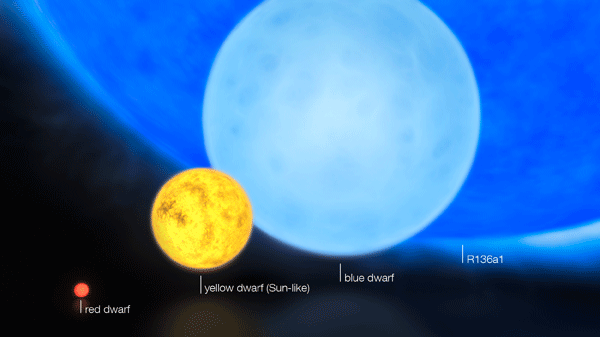Massive Blue Supergiant Challenges Theory of How Big a Star Can Be

Welcome to the Tarantula Nebula, home to heavy-weight stars. Using data from the Hubble Space Telescope and Very Large Telescope in Chile, scientists have found a star estimated at about 265 times the mass of the sun. That makes it by far the most massive star ever found, and challenges astronomers’ notions of just how big a star can get.
The Tarantula Nebula is 165,000 light years away in the the Large Magellenic Cloud galaxy. This star, called R136a1, is located in the R136 stellar cluster; with 10 million times the luminosity of the sun, it’s the brightest of a bevy of massive stars recently discovered. The finding, published earlier this month in the Monthly Notices of the Royal Astronomical Society, may require scientists to come up with a new stellar life cycle for the most massive stars. The life a star leads depends on its mass, and the previously estimated mass limit was thought to be around 150 times the sun’s mass.
Lead author Paul Crowther explains that the big guy falls into the stellar category of “blue supergiants,” which are still a mystery from start to finish: It’s not clear whether a star can be born this big, or whether it grows through mergers.
Supergiants also remain as much of a puzzle at the end of their lives. Although all will eventually go supernova, the type of explosion they will generate is unknown. They could form neutron stars or black holes or obliterate themselves. Whatever their fate is, he says, “We still can’t say.” [ScienceNOW]

Finding such massive stars is difficult, given their scarcity and relative short-lives. Many don’t live long enough to escape the crowd of their stellar birthplace, making them hard to spot and making it possible for scientists to confuse two closely paired stars for one bigger star. The team doesn’t think they’ve made that mistake.
Scientists said the authors had made a strong case, arguing that the solar material being thrown off from feuding stars in a binary system would produce much more powerful X-rays than have been detected. [AP]
Just like spotting the stars, measuring their mass is also difficult. With a star that is part of a binary system, scientists can look at how one influences the orbit of the other to determine mass, but the team had no such convenient companions for R136a1. They instead used a model to predict the star’s mass based on analysis of the light coming from it, which yields a less exact result.
That means we can’t be sure just how massive R136a1 is, or how massive it was when it was born. “I think they’ve gotten a very believable answer,” says Philip Massey of the Lowell Observatory in Flagstaff, Arizona. “It’s certainly a very significant find,” he adds, though he says many astronomers already suspected that 150 solar masses was not a hard limit. “I think most people will view this [with] glee and say ‘I told you so’.” [New Scientist]
What might it be like to live around such a massive star? Scientists say it’s unlikely that such stars could ever have planetary neighbors, but that living near R136a1 would certainly be bright.
“Planets take longer to form than these stars take to live and die. Even if there were planets, there would be no astronomers on them because the night sky would be almost as bright as the day in these clusters,” Professor Crowther joked. . . . “Some of these big stars are relatively close to each other, so even at ‘night’ you’d have another very bright star shining on you.” [BBC]
Images: ESO
Source: Massive Blue Supergiant Challenges Theory of How Big a Star Can Be